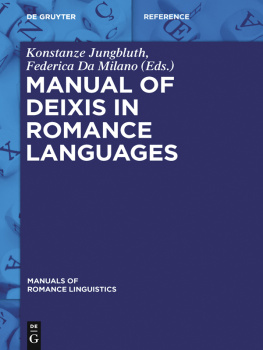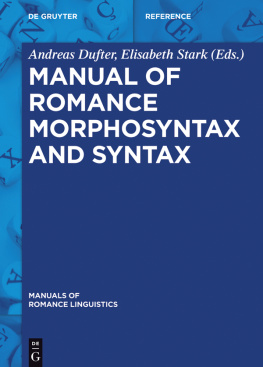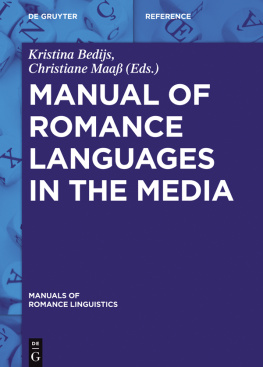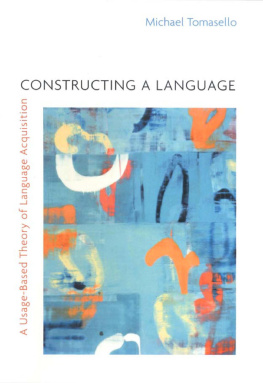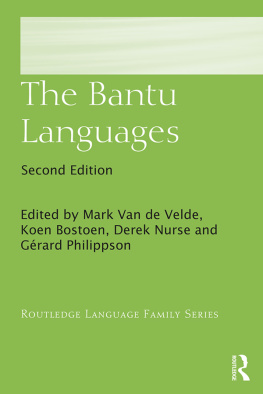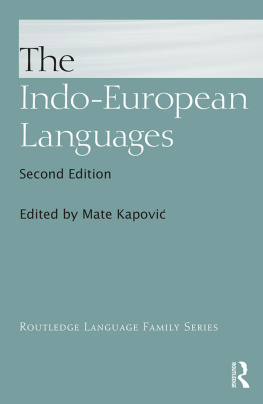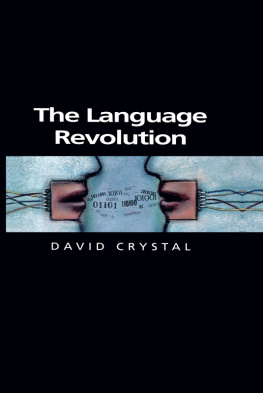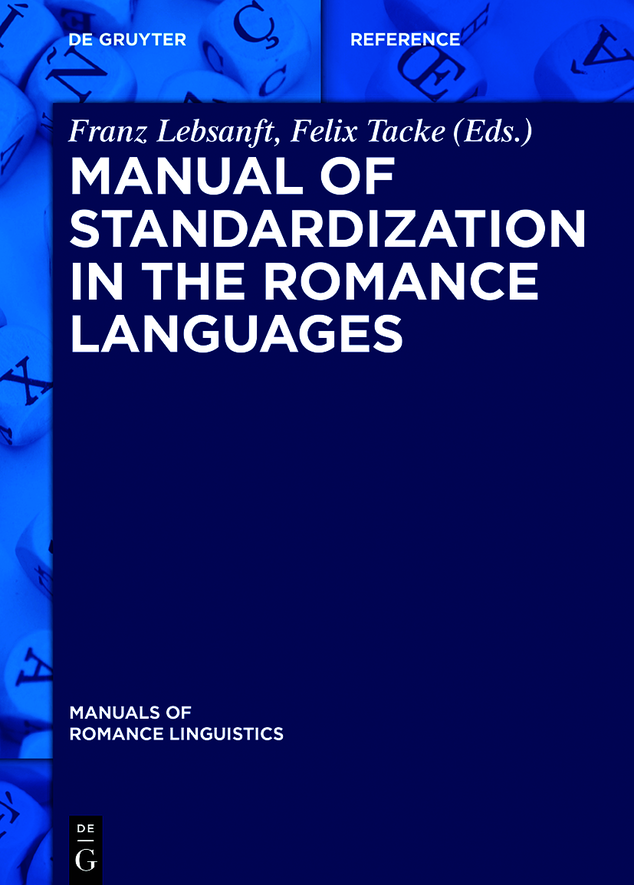Manuals of Romance Linguistics
Edited by
Gnter Holtus
Fernando Snchez-Miret
Volume
ISBN 9783110455731
e-ISBN (PDF) 9783110458084
e-ISBN (EPUB) 9783110456066
Bibliographic information published by the Deutsche Nationalbibliothek
The Deutsche Nationalbibliothek lists this publication in the Deutsche Nationalbibliografie; detailed bibliographic data are available on the Internet at http://dnb.dnb.de.
2020 Walter de Gruyter GmbH, Berlin/Boston
Manuals of Romance Linguistics
The new international handbook series Manuals of Romance Linguistics (MRL) will offer an extensive, systematic and state-of-the-art overview of linguistic research in the entire field of present-day Romance Studies.
MRL aims to update and expand the contents of the two major reference works available to date: Lexikon der Romanistischen Linguistik (LRL) (19882005, vol. 18) and Romanische Sprachgeschichte (RSG) (20032008, vol. 13). It will also seek to integrate new research trends as well as topics that have not yet been explored systematically.
Given that a complete revision of LRL and RSG would not be feasible, at least not in a sensible timeframe, the MRL editors have opted for a modular approach that is much more flexible:
The series will include approximately 60 volumes (each comprised of approx. 400600 pages and 1530 chapters). Each volume will focus on the most central aspects of its topic in a clear and structured manner. As a series, the volumes will cover the entire field of present-day Romance Linguistics, but they can also be used individually. Given that the work on individual MRL volumes will be nowhere near as time-consuming as that on a major reference work in the style of LRL, it will be much easier to take into account even the most recent trends and developments in linguistic research.
MRLs languages of publication are French, Spanish, Italian, English and, in exceptional cases, Portuguese. Each volume will consistently be written in only one of these languages. In each case, the choice of language will depend on the specific topic. English will be used for topics that are of more general relevance beyond the field of Romance Studies (for example Manual of Language Acquisition or Manual of Romance Languages in the Media).
The focus of each volume will be either (1) on one specific language or (2) on one specific research field. Concerning volumes of the first type, each of the Romance languages including Romance-based creoles will be discussed in a separate volume. A particularly strong focus will be placed on the smaller languages (linguae minores) that other reference works have not treated extensively. MRL will comprise volumes on Friulian, Corsican, Galician, among others, as well as a Manual of Judaeo-Romance Linguistics and Philology. Volumes of the second type will be devoted to the systematic presentation of all traditional and new fields of Romance Linguistics, with the research methods of Romance Linguistics being discussed in a separate volume. Dynamic new research fields and trends will yet again be of particular interest, because although they have become increasingly important in both research and teaching, older reference works have not dealt with them at all or touched upon them only tangentially. MRL will feature volumes dedicated to research fields such as Grammatical Interfaces, Youth Language Research, Urban Varieties, Computational Linguistics, Neurolinguistics, Sign Languages or Forensic Linguistics. Each volume will offer a structured and informative, easy-to-read overview of the history of research as well as of recent research trends.
We are delighted that internationally-renowned colleagues from a variety of Romance-speaking countries and beyond have agreed to collaborate on this series and take on the editorship of individual MRL volumes. Thanks to the expertise of the volume editors responsible for the concept and structure of their volumes, as well as for the selection of suitable authors, MRL will not only summarize the current state of knowledge in Romance Linguistics, but will also present much new information and recent research results.
As a whole, the MRL series will present a panorama of the discipline that is both extensive and up-to-date, providing interesting and relevant information and useful orientation for every reader, with detailed coverage of specific topics as well as general overviews of present-day Romance Linguistics. We believe that the series will offer a fresh, innovative approach, suited to adequately map the constant advancement of our discipline.
| August 2019 | Gnter Holtus (Lohra/Gttingen) |
| Fernando Snchez-Miret (Salamanca) |
Preface
The standardization of Romance languages is a well-established domain in Romance studies. As shown in our detailed introduction (Romance standardology: roots and traditions), there is a considerable amount of research on this classical issue, and all the contributors to this manual draw heavily on it. However, this volume strives to do more than just provide an essential update of previous research findings. The first part of the book, dedicated to the theories of linguistic norm, presents, of course, overviews on traditional and proven methodologies, which have constantly enhanced our understanding of standardization. Nonetheless, it also ventures to include more recent approaches to the construction of regulated forms of language that are not easily found in former manuals. In the same manner, the second part on language-specific instruments and reference tools combines articles treating the traditional realm of language codification and modernization (i.e., orthographies, normative dictionaries and grammars). This engaging sectionencompasses elaborate analysis of the hitherto neglected issue of normative pronunciation (orthoepy) as well as the ever more dynamic field of usage guides (the so-called dictionaries of language difficulties).
From the standpoint of standardization, it is justifiable to distinguish between major and minor Romance languages. The chapters on Romanian, Italian, French, Catalan, Spanish and Portuguese always follow the same, full-fledged scheme (four articles each); a more concise chapter is dedicated to minor Italo-, Gallo- and Ibero-Romance languages not to mention Romance-based Creoles. Even though each language is treated separately, the introductory essay additionally contains a sectionintended to provide the reader with a comparative approach.
It goes without saying that in order to be useful and easily accessible, a manual needs a coherent structure and an analogous, corresponding treatment of the objects. However, if the reader detects excessive or disturbing heterogeneity in the presentation of (some of) the data, we as editors have failed to convince the contributors of the well-foundedness of our approach. We assume, of course, responsibility for any shortcomings in this respect.
Many esteemed colleagues have contributed to making the idea of a Manual of Standardization in the Romance Languages come true. First of all, wed like to thank our General Series Editors Gnter Holtus and Fernando Snchez-Miret for their patience and support; of course, a lot of gratitude goes out to the many contributors of this volume those who have fulfilled the promise of a substantial article and those who have generously helped us out in the case of a few missing articles by assuming that task on short notice. Furthermore, we also wish to thank Steven Dworkin for his advice in the early stages of this volume. We would also like to express our appreciativeness to Brandon Davenport, who has tirelessly improved the style of many manuscripts, as well as to Judith Strunck, Thea Ghring and Judith Harzheim, who rendered their services of laboriously reading and copy-editing the whole volume. Last but not least, many thanks to the DeGruyter editorial team for their unconditional assistance we received during the long editing process: Ulrike Krau, Christine Henschel, Gabrielle Cornefert, Anna Hofs and Monika Pfleghar.


